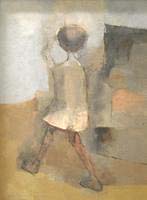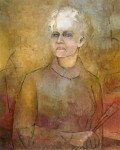
Cordelia Urueta
Mexican, 1908-1995
Niña (Child), 1966
oil on canvas
29 3/4 x 21 1/2 in.
SBMA, Gift of Charles A. Storke
1994.57.49

Self-portrait of Urueta, 1965
COMMENTS
As a young child, Cordelia Urueta became acquainted with Italian Renaissance artists Raphael and Michelangelo through reproductions and plaster copies belonging to her father, art critic and Mexican ambassador to Argentina and Uruguay, Jesús Urueta Siqueiros. Her father’s untimely death caused Urueta to withdraw from reality, falling ill and finding comfort in books and long walks in the countryside. Pioneering Mexican painter and writer, Dr. Atl, encouraged Urueta to pursue art more seriously after examining her drawings. She studied with Alfredo Ramos Martínez at the Escuela de Pintura al Aire Libre (Open Air School of Painting) in Churubusco. Urueta formed her own distinctive style that fluctuated between figuration and abstraction throughout her career.
After several years in Paris and New York, Urueta returned with husband, artist Gustavo Montoya, to permanently settle in Mexico in 1950. Niña is an expressive work that experiments with various light sources and the dimensionality of neutral colors. The subtle palette of this painting creates the soft outline of a figure in motion—perhaps a recollection of childhood.
SBMA title card information 2013
Cordelia Urueta was born on September 16, 1908 in Coyoacán (then separate from Mexico City) into a family of intellectuals, artists, diplomats and filmmakers. Her father was Jesús Urueta Siqueiros, an art critic with Revista Moderna who was also a speaker and diplomat. Her mother was Tarsila Sierra, daughter of journalist Santiago Sierra and niece of educator Justo Sierra, who was Cordelia’s tutor. She was a cousin of David Alfaro Siqueiros, and her sister Margarita Urueta, would later become a noted playwright.
She grew up during the Mexican Revolution and her father was heavily involved in efforts to unite the various factions vying for power after the ousting of Porfirio Díaz. Her childhood home was also the home of the magazine Revista Moderna. The prints of the magazines attracted her attention to art as well as the images from the many books of the family library. Urueta did not remember when she began to draw, but it was mostly to copy the art she saw in the books. She was expelled from school when she was young for drawing pictures of nuns who were clothed on the front of the paper but naked on the back. Her father then hired the best painting teacher he could find, Dr. Atl (who she called Uncle Murillo) he was the first to recognize her talent after seeing some of her portraits.
In 1919, the family moved to Buenos Aires after her father received a diplomatic post but returned after her father died in 1920. Cordelia was only eleven years old and fell into poor health from mourning her fathers death.
In the 1920s, artist Alfredo Ramos Martínez began the Escuela de Pintura de Aire Libre in Churubusco at which she took classes. She preferred drawing, often doing portraits of servants and of her friends. Urueta said that her time with the school was important as it taught her the value of nationalistic themes as well as those related to the Mexican people. It also taught her that art was a true vocation rather than just a hobby.
Her health continued to be poor and in 1929 her mother took her to New York to visit a relative. There she met poet José Juan Tablada, a distant relative, who introduced her to Alma Reed, owner of Delfic Studios art gallery and noted promoter of Mexican art. Reed invited Urueta to participate in a collective exhibition along with José Clemente Orozco and Rufino Tamayo, but after this her health forced her to temporarily retire from painting. However, Orozco commented favorably on her work.
In 1932 she returned to the fine arts as an art teacher with the Secretaría de Educación Pública . Through the SEP, she began to meet a number of prominent Mexican artists including Leopoldo Méndez, Juan Soriano, Carlos Mérida, María Izquierdo, Francisco Gamboa and Pastor Velázquez . Because she did not have extensive academic preparation, she used her connections to learn, especially from Gustavo Montoya, who had studied at the Academy of San Carlos. At Pastor Velazquez’s workshop she was permitted to draw the models he employed. She rented studio space with Montoya and two other artists in spite of the fact that this caused her problems with her family.
In 1938, she used her family’s connections to obtain a chancellor post at the Mexican embassy in Paris. While preparing for the trip, Montoya proposed to her. She accepted on the condition that he accompanies her. In Paris, they came across David Alfaro Siquieros, a cousin and spent time with him and other artists in the cafes of the city. Their time there contributed to the artistic development of both. Shortly before World War II began, the Paris embassy staff was evacuated with Urueta and Montoya transferred to the New York consulate. There Urueta became interested in the work of Picasso and Braque .
She returned permanently to Mexico to paint professionally, reaching her peak in the late 1950s into the 1960s. From that time until her death, she had a wide circle of intellectual and artist friends which included Elena Poniatowska, Carlos Fuentes, Juan Soriano, Luis Barragán, Xavier Villarrutia, María Izquierdo, Alfredo Zalce and Daniel Cosío Villegas .
In 1965, she and Montoya divorced after twenty-six years of marriage, which upset her greatly. She died at age 87 on November 3, 1995 after a long illness and buried at Panteón Jardin in Mexico City.
She was a painter, teacher, diplomat and art promoter and a founding member of the Salón de la Plástica Mexicana . She worked as an art teacher starting in 1932 until she left in 1938 to live in Paris. Her art career was on hold until 1950, when she and her husband returned to Mexico and she dedicated herself to painting and exhibitions. Her first was with the Salón de la Plástica Mexicana in 1950. Family friend and supporter Dr. Atl wrote the introduction to the catalog of this event. She had a major individual exhibition at the Museo de Arte Moderno in 1970, which also did a retrospective of her work in 1985.
Her best work is considered to be that of the late 1950s and early 1960s, winning biennals such as the Interamericana de Pintura and the VI Bienal in Sao Paulo, Brazil in 1961.
Although she was not integrated into Mexico’s artistic scene, her work mostly fits into the then dominant Mexican School of Painting, especially her earlier work that often focused on portraits. Her artistic development was to strive to find her own style and she succeeded in creating a number of novelties, such as figures that eventually disappeared, ceding importance to textures and color.
She felt that the use of color best expressed her emotions, with her work best noted for its use of color, considered to be one of Mexico ‘s “great colorists.” Her later work became more abstract but with frequent reference to the human form, showing influence from Tamayo. She has been called the “Grande Dame of Abstract Art.”
References
(in Spanish) Siglo XX: Grandes maestro mexicanos [20th century: Great Mexican masters]. Monterrey, Mexico: Museo de Arte Contemporáneo de Monterrey. 2004. pp. 355–356. ISBN 968 6623 56 6.
García Barragán, Elisa (1990) (in Spanish). Cordelia Urueta y el color [Cordelia Urueta and color]. Mexico City: UNAM. pp. 2–21. ISBN 968-837-628-5.
(in Spanish) Tesoros del Registro Civil Salón de la Plástica Mexicana [Treasures of the Civil Registry Salón de la Plástica Mexicana]. Mexico: Government of Mexico City and CONACULTA. 2012. p. 216. ISBN 03 2012 041612033800 07.
"Muere Cordelia Urueta [Cordelia Urueta dies]" (in Spanish). Reforma (Mexico City): p. 3. November 4, 1995.
Elizonde, Lupina Laura, ed. (2001) (in Spanish). Visión de México y sus Artistas Siglo XX 1901-1950 [Vision of Mexico and its Artists 20th century 1901-1950]. Mexico City: Qualitas Compaía de Seguros SA de CV. pp. 200–203. ISBN 968-5005-58-3.
Edited and transcribed for the SBMA Docent Council website by Loree Gold, 2013, for reference and educational use only, gathered from:
http://en.wikipedia.org/wiki/Cordelia_Urueta
